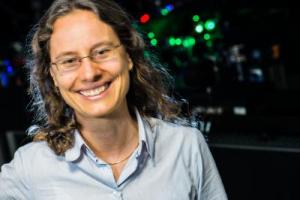Jun 20 2014
Rice lab's unique spectrometer will shed light on solar-powered CO2 reduction
It's difficult to define Rice University scientist Isabell Thomann, whose research encompasses chemistry, optics, electrical engineering, energy and the environment -- just to name a few. But thanks to a prestigious CAREER Award from the National Science Foundation (NSF), Thomann's got the chance to focus her energies on a five-year quest to explore ways of using sunlight to reduce the carbon footprint of power plants.
 This image depicts Isabell Thomann from Rice University. Credit: Jeff Fitlow/Rice University
This image depicts Isabell Thomann from Rice University. Credit: Jeff Fitlow/Rice University
"We are interested in improving photocatalysis, a class of processes in which we use light to drive chemical reactions," Thomann said. "This grant will focus on the reduction of carbon dioxide using sunlight, but the methods that we study in our lab can be broadly applied across many disciplines."
CAREER Awards are among the NSF's most competitive. Only about 400 are given each year across all disciplines. The awards, which include $400,000 in research funding, are given to "junior faculty who exemplify the role of teacher-scholars through outstanding research, excellent education and the integration of education and research within the context of the mission of their organizations," according to the NSF.
Thomann holds joint appointments in Rice's departments of Electrical and Computer Engineering, Chemistry, and Materials Science and NanoEngineering. One facet of her work focuses on designing and testing photocatalytic nanomaterials -- tiny bits of matter that interact with light to foster chemical reactions.
"Typically in a chemical reaction, you have a reactant, or chemical input A, that is used to produce a chemical product B," Thomann said. "It's rare that a reaction goes directly from A to B. Often there are a number of short-lived, intermediate chemicals that are produced in between. We would like to better understand what these short-lived intermediates are so we can better control the output of the chemical reactions."
One reason intermediate chemicals are often overlooked and poorly studied is that they exist for a short time -- sometimes just a fraction of a second -- before they are consumed by a subsequent reaction.
"Probing these is a real challenge because of the fast timescales involved," Thomann said. "We are developing an ultrafast laser spectroscopy system that, in essence, allows us to take a movie of the short-lived chemical intermediates as they come and go."
The spectrograph can read the optical signatures of molecules. These act like fingerprints that her team can use to determine exactly which intermediates are present and in what concentration at any point throughout the reaction. By running repeated tests under a variety of reaction conditions, Thomann's team hopes to learn how to optimize the efficiency and selectivity of chemical reactions.
"We are building this tunable laser source with lots of different colors because not every reaction is alike," Thomann said. "With this tunable laser system, we can shine light of any color to study different chemicals."
In the case of carbon dioxide, the research could allow chemical engineers to optimize solar-powered CO2 conversion systems for a variety of different parameters.
"Every application is a bit different, and this is the kind of knowledge engineers need to meet a specific challenge," she said. "In one case, the limiting factor might be the upfront cost of building the system. In another instance, the engineer might be more interested in optimizing output. In each case, it is important to understand exactly how the reaction takes place."
Thomann said energy and green chemistry are but two of the research themes in her lab.
"We are definitely interested in materials for energy applications, particularly for those involving solar photocatalysis," Thomann said. "But energy is just one of the big challenges of our day. There are also other challenges in sensing and in health. Over time, we aim to be part of solving or helping to solve other grand challenges through the use of nanophotonics."
Source: http://www.rice.edu/